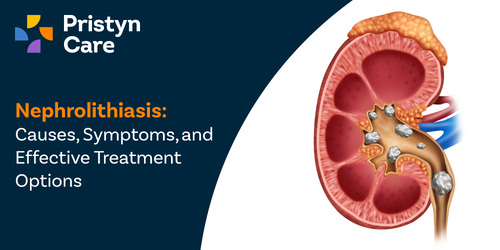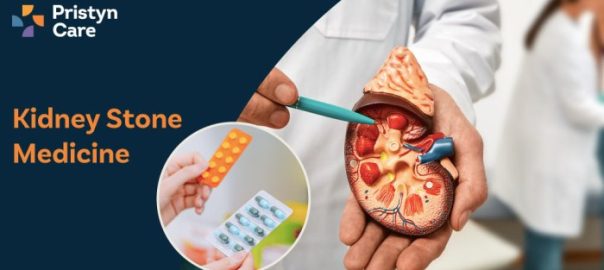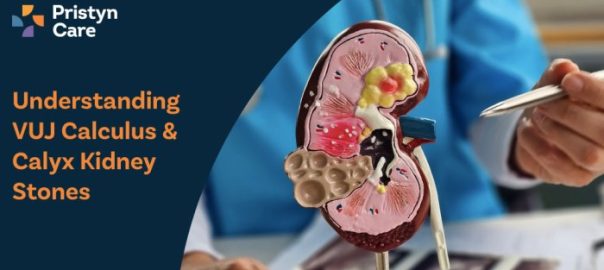![]() Views: 1,218
Views: 1,218
Nephrolithiasis: Causes, Symptoms & Effective Treatment Options
Nephrolithiasis, commonly known as kidney stones, affects many people globally, causing significant pain and discomfort. Understanding the causes, recognising the symptoms early, and knowing the effective treatment options can help you manage this con...
dition better. Don't let kidney stones impact your quality of life. If you are experiencing symptoms that might indicate nephrolithiasis, book your appointment today and consult with our experienced doctors at Pristyn Care. Read moreDedicated Support at Every Step!
Our Doctors are available 24 hours a day, 7 days a week to help you!
Table of Contents
What Is Nephrolithiasis?
Nephrolithiasis refers to the condition where solid mineral deposits or stones form in the kidneys. The size of these stones varies, and as they move through the urinary tract, they may cause significant discomfort and pain. Although nephrolithiasis can affect anyone, certain risk factors increase the likelihood of stone formation. A urologist, a doctor who specialises in diseases of the urinary tract, would be the best specialist to consult for this condition.
In India, nephrolithiasis is a prevalent condition affecting thousands every year. This condition requires timely diagnosis and treatment to prevent complications such as kidney damage or recurrent urinary tract infections. Moreover, kidney stones are not gender-specific and can affect both men and women of all age groups. Certain factors, such as dietary habits, environmental conditions, and genetic predisposition, may increase the risk of developing kidney stones. However, a range of treatment options are available to effectively manage this condition and improve quality of life.
No Cost EMI, Hassle-free Insurance Approval
What Causes Nephrolithiasis?
The formation of kidney stones involves several contributing factors:
Biological Factors
- High urinary concentration of substances such as calcium, oxalate, uric acid, or cystine that promote stone formation.
- Low levels of urinary citrate
- Genetic predisposition due to inherited metabolic disorders affecting stone formation
Dietary Factors
- Dehydration leads to concentrated urine, promoting stone formation.
- High sodium intake causes increased calcium excretion in urine.
- Consumption of foods rich in oxalate, such as spinach and nuts.
- Diets high in animal protein increase uric acid levels and reduce urinary citrate.
Environmental Factors
- Hot climates lead to dehydration and reduced urine volume.
- A sedentary lifestyle promotes obesity and metabolic changes that increase stone development.
Medical Conditions
- Certain conditions like hyperparathyroidism, renal tubular acidosis, gout, and specific gastrointestinal diseases alter mineral absorption and excretion, thus predisposing individuals to nephrolithiasis.
Types Of Nephrolithiasis
Nephrolithiasis, commonly known as kidney stones, occurs when solid mineral deposits form in your kidneys. Let's delve into the four main types of kidney stones:
- Calcium Oxalate: These are the most rampant type of kidney stones, brought about by the combination of calcium and oxalate in your urine.
- Calcium Phosphate: These are not as common and are usually linked with metabolic conditions such as renal tubular acidosis.
- Uric Acid Stones: These form when your urine is overly acidic, which can be due to a high protein diet or conditions increasing uric acid levels.
- Struvite Stones: These typically develop as a response to urinary tract infections (UTIs) and are made up of magnesium, ammonium, and phosphate.
- Cystine Stones: These arise from a genetic disorder called cystinuria that leads to excessive excretion of certain amino acids, leading to stone formation.
Symptoms Of Nephrolithiasis
The symptoms of nephrolithiasis range based on the size and location of the stone. The most common symptoms are:
- Severe pain: This pain is often sharp or cramping, starting from the lower back or side and radiating towards the abdomen or groin.
- Haematuria: Blood present in the urine may give it a pink, red, or brown colour.
- Nausea and vomiting: These often accompany the severe pain.
- Frequent Urination: A strong urge to urinate more often than usual.
- Cloudy or foul-smelling urine: An indication of an infection.
- Fever and chills: These are signs that an infection might be accompanying the stones.
Diagnosis And Evaluation Of Nephrolithiasis
Diagnosing nephrolithiasis involves a combination of clinical assessments, laboratory tests, and imaging studies.
- Physical examination: Initially, the doctor will conduct a medical history review and physical examination to assess symptoms such as severe flank pain, haematuria, nausea, vomiting, and any history of UTIs.
- Laboratory tests: Further, lab tests such as urinalysis are conducted to detect haematuria or the presence of stone-forming substances in the urine. Blood tests can also be undertaken to assess kidney function and identify metabolic abnormalities that could contribute to stone formation.
- Imaging studies: Studies like non-contrast CT scans provide detailed images confirming the presence, size, and location of stones. Other techniques like ultrasound and X-rays can also be used based on the patient's condition.
How Nephrolithiasis Can Be Treated?
Treatment for nephrolithiasis depends on the size, type, and location of the stones as well as the severity of symptoms. Here are some treatment options:
- Conservative management: This includes increasing fluid intake to help pass small stones. Over-the-counter pain relievers can also be used to alleviate pain.
- Medical treatment: Medications like potassium citrate and Thiazide diuretics are used to prevent stone formation.
- Minimally Invasive Procedures: Procedures like Extracorporeal Shock Wave Lithotripsy (ESWL) or Ureteroscopy are used to break kidney stones into smaller fragments that can be passed more easily in urine.
- Surgical options: Percutaneous Nephrolithotomy (PCNL) or Nephrostomy Tube Placement are used for larger or more complex stones where a small incision is made in the back to locate and remove the stone.
- Dietary modifications: Depending on the type of stone formed, changes in diet might be recommended to prevent the future formation of kidney stones.
Understanding nephrolithiasis aids in early diagnosis, prompt treatment, and prevention of future formation. Always consult your doctor if you suspect you may have kidney stones.
When Is Nephrolithiasis Considered Serious?
Nephrolithiasis is a condition that can sometimes escalate into a serious health concern. The seriousness of this condition depends on the size of the stones, their location, and the symptoms they produce. Here are some key factors that indicate when nephrolithiasis could be serious:
- Severe pain: A sudden, intense pain that typically begins in the lower back and radiates to the abdomen and groin could indicate renal colic, a condition associated with nephrolithiasis. This severe pain, often accompanied by nausea and vomiting, might require immediate medical attention.
- Obstruction of urine flow: If a kidney stone blocks the ureter, it can lead to a backup of urine in the kidney, causing hydronephrosis. This condition can result in kidney damage if not treated swiftly.
- Infection: Nephrolithiasis increases the risk of UTIs. Symptoms such as fever, chills, and cloudy or foul-smelling urine may indicate an infection.
- Haematuria: Blood in the urine can occur with kidney stones and warrants further evaluation.
- Large stone size: Stones larger than 5 mm may require intervention as they rarely pass naturally.
- Chronic kidney disease risk: Recurrent kidney stones or untreated stones can lead to chronic kidney disease over time.
Prevention of Nephrolithiasis
Preventing nephrolithiasis primarily involves lifestyle changes and dietary modifications. It involves:
- Drink plenty of fluids daily to dilute your urine.
- Limit animal protein consumption like beef, fish, and poultry.
- Maintain a balanced diet that includes calcium-rich foods, as it helps bind oxalate in your intestines.
Consult your family physician if you have a history of nephrolithiasis for personalised advice.
Myths & Facts About Nephrolithiasis
When it comes to nephrolithiasis, there are several misconceptions. Let’s debunk some of these myths:
Myth 1: Avoiding calcium prevents kidney stones.
Fact: Dietary calcium helps prevent calcium oxalate stones by binding with oxalate in the intestines.
Myth 2: Drinking beer helps pass kidney stones.
Fact: Beer may worsen kidney stone formation due to potential dehydration.
Myth 3: Cranberry juice prevents kidney stones.
Fact: Cranberry juice may actually worsen kidney stone problems due to its high oxalate content.
Myth 4: All kidney stones cause severe pain.
Fact: Some small stones may pass without causing significant discomfort.
Questions To Ask Your Doctor About Nephrolithiasis
Some important questions to ask your doctor about nephrolithiasis include:
- What are kidney stones, and how do they form?
- What dietary changes can I make to prevent kidney stones?
- Are there specific risk factors that increase my chances of developing kidney stones?
- Can certain medications contribute to the formation of kidney stones?
- Can kidney stones cause long-term damage to my kidneys?
- How do I know if my kidney stone is small enough to pass on its own?
- Can kidney stones cause long-term damage to my kidneys?
- What should I do if I experience severe pain or other symptoms again after treatment for kidney stones?
FAQs
1. How can I prevent kidney stones?
Prevention strategies include staying well-hydrated, making dietary modifications (reducing salt and oxalate intake), maintaining a healthy weight, and consulting with a healthcare provider for personalised advice.
2. How common is nephrolithiasis in India?
According to various studies conducted in India, approximately 12% of the population is expected to have nephrolithiasis at some point in their life. The occurrence of kidney stones tends to be higher in men compared to women.
3. What does bilateral nephrolithiasis imply?
Bilateral nephrolithiasis implies the presence of kidney stones in both kidneys. Though it may sound more serious, it's a treatable condition. However, it requires prompt attention to prevent complications like kidney damage.
4. Are left nephrolithiasis and right nephrolithiasis different?
Left nephrolithiasis refers to the formation of kidney stones in the left kidney, while right nephrolithiasis refers to stone formation in the right kidney. The symptoms for both are essentially identical and may include pain on one side of the body, blood in urine, and frequent urination. Treatment options are similar for both conditions.
5. What is multiple nephrolithiasis?
Multiple nephrolithiasis refers to a condition where multiple stones have formed within one or both kidneys. This can significantly increase discomfort and risk for complications, including renal failure if not promptly treated.
6. How long does it take to recover after passing a kidney stone?
Recovery time varies; small stones may pass with minimal discomfort within days, while larger stones requiring treatment may take several weeks for full recovery.
7. What lifestyle modifications can prevent nephrolithiasis?
To prevent nephrolithiasis, it's important to drink ample fluids each day, decrease sodium intake, eat fewer oxalate-rich foods, get enough calcium in your diet, limit animal protein intake, and maintain a healthy body mass index (BMI). Regular follow-ups with your doctor also help to monitor your health and implement preventive measures if required.
8. Can children develop kidney stones?
Yes, children can develop kidney stones, although it is less common than in adults. Factors such as dehydration and dietary habits play a role.












